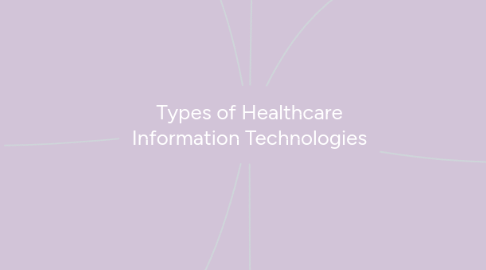
1. Computerized Provider Order Entry
1.1. Designed to replace a hospital's paper-based ordering system.
1.1.1. Users are able to electronically write a full range of orders
1.1.2. Maintain an online medication administration record
1.1.3. Review changes made to an order by successive personnel
1.1.4. Increase efficiency and improve patient safety and patient care
1.1.5. Offer safety alerts that are triggered when an unsafe order is entered
2. Consumer Health IT Applications
2.1. Allow patients to manage, share, and control their health information electronically and to assume a more active role in the management of their health
2.1.1. Self-Management System
2.1.2. Electronic Personal Health Records and Patient Portals
2.1.3. Peer Interaction Systems
3. Electronic Medical Record Systems
3.1. Digital charts used in offices, clinics, and hospitals. Digital charts include:
3.1.1. Notes and information collected in the facility, used by providers to diagnose and treat patients.
3.1.2. Gives providers the ability to track data
3.1.3. Monitors patients need for preventative screenings and improves patients overall health
4. Clinical Decision Support
4.1. Health information technology system that is designed to provide physicians and other health professionals with clinical decision support, that is, assistance with clinical decision-making tasks
4.1.1. Increases quality of care and enhances health outcomes
4.1.2. Improves provider and patient satisfaction
4.1.3. Helps avoid errors and adverse events
5. Computerized Disease Registry
5.1. A disease registry is a tool for tracking the clinical care and outcomes of a defined patient population.The basic architecture of computerized disease registries consists of three components:
5.1.1. A database (server, database management system software, and management tools) to store patient information.
5.1.2. A data model to organize and integrate information in the registry.
5.1.3. Software tools that allow users to sort, manipulate, and create views and reports from the information in the registry.
6. Electronic Prescribing
6.1. Health care providers can enter prescription information into a computer device and securely transmit the prescription to pharmacies using a special software program and connectivity to a transmission network
6.1.1. Help improve health care quality and patient safety by reducing medication errors and checking for drug interactions
6.1.2. Make care more convenient by allowing providers to electronically request prescription refills
6.1.3. Prescriptions tend to be cheaper through electronic prescribing.
7. Telehealth
7.1. System that supports long-distance clinical healthcare and education. Technologies include:
7.1.1. Live (synchronous) videoconferencing: a two-way audiovisual link between a patient and a care provider
7.1.2. Store-and-forward (asynchronous) videoconferencing: transmission of a recorded health history to a health practitioner, usually a specialist.
7.1.3. Remote patient monitoring (RPM): the use of connected electronic tools to record personal health and medical data in one location for review by a provider in another location, usually at a different time.
7.1.4. Mobile health (mHealth): health care and public health information provided through mobile devices. The information may include general educational information, targeted texts, and notifications about disease outbreaks.
